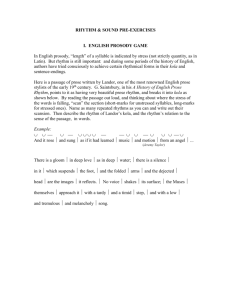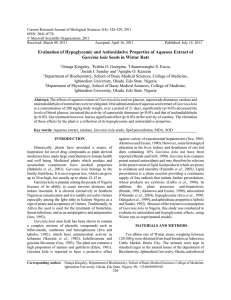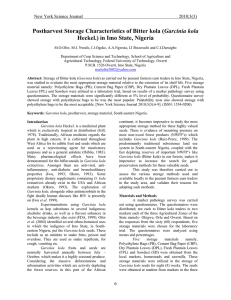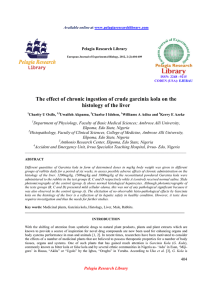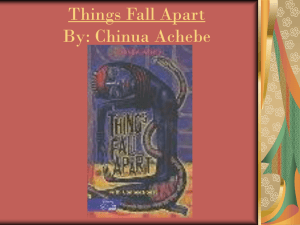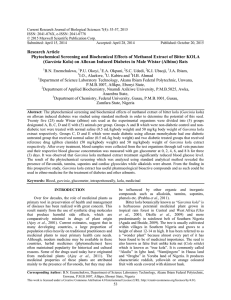Document 14233373
advertisement
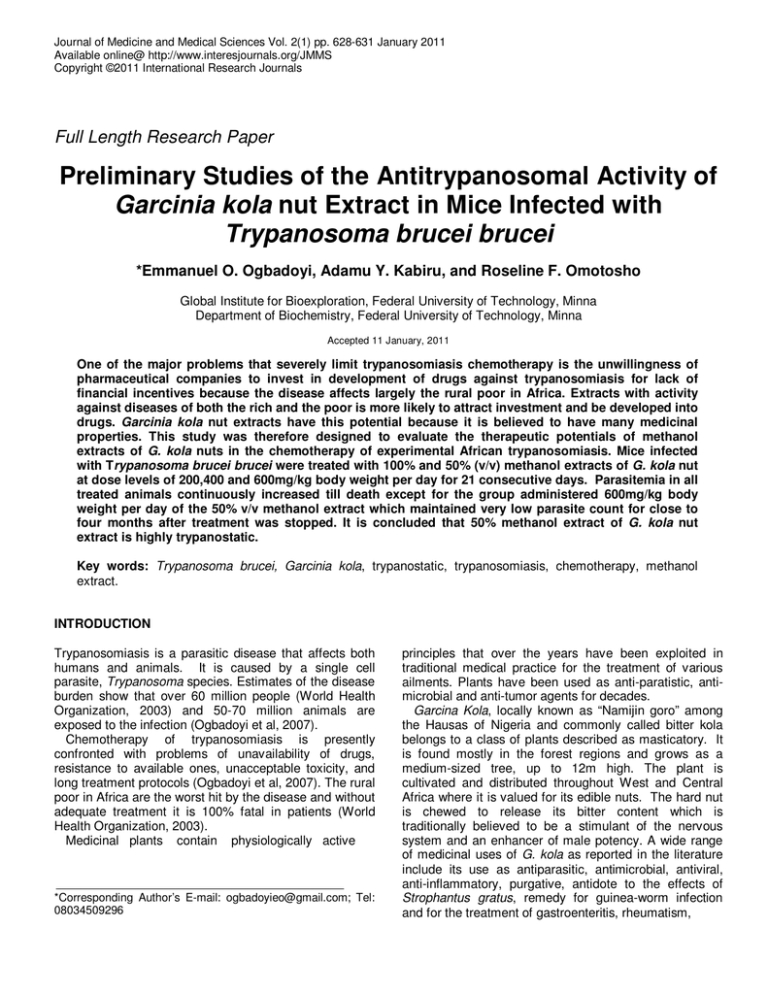
Journal of Medicine and Medical Sciences Vol. 2(1) pp. 628-631 January 2011 Available online@ http://www.interesjournals.org/JMMS Copyright ©2011 International Research Journals Full Length Research Paper Preliminary Studies of the Antitrypanosomal Activity of Garcinia kola nut Extract in Mice Infected with Trypanosoma brucei brucei *Emmanuel O. Ogbadoyi, Adamu Y. Kabiru, and Roseline F. Omotosho Global Institute for Bioexploration, Federal University of Technology, Minna Department of Biochemistry, Federal University of Technology, Minna Accepted 11 January, 2011 One of the major problems that severely limit trypanosomiasis chemotherapy is the unwillingness of pharmaceutical companies to invest in development of drugs against trypanosomiasis for lack of financial incentives because the disease affects largely the rural poor in Africa. Extracts with activity against diseases of both the rich and the poor is more likely to attract investment and be developed into drugs. Garcinia kola nut extracts have this potential because it is believed to have many medicinal properties. This study was therefore designed to evaluate the therapeutic potentials of methanol extracts of G. kola nuts in the chemotherapy of experimental African trypanosomiasis. Mice infected with Trypanosoma brucei brucei were treated with 100% and 50% (v/v) methanol extracts of G. kola nut at dose levels of 200,400 and 600mg/kg body weight per day for 21 consecutive days. Parasitemia in all treated animals continuously increased till death except for the group administered 600mg/kg body weight per day of the 50% v/v methanol extract which maintained very low parasite count for close to four months after treatment was stopped. It is concluded that 50% methanol extract of G. kola nut extract is highly trypanostatic. Key words: Trypanosoma brucei, Garcinia kola, trypanostatic, trypanosomiasis, chemotherapy, methanol extract. INTRODUCTION Trypanosomiasis is a parasitic disease that affects both humans and animals. It is caused by a single cell parasite, Trypanosoma species. Estimates of the disease burden show that over 60 million people (World Health Organization, 2003) and 50-70 million animals are exposed to the infection (Ogbadoyi et al, 2007). Chemotherapy of trypanosomiasis is presently confronted with problems of unavailability of drugs, resistance to available ones, unacceptable toxicity, and long treatment protocols (Ogbadoyi et al, 2007). The rural poor in Africa are the worst hit by the disease and without adequate treatment it is 100% fatal in patients (World Health Organization, 2003). Medicinal plants contain physiologically active *Corresponding Author’s E-mail: ogbadoyieo@gmail.com; Tel: 08034509296 principles that over the years have been exploited in traditional medical practice for the treatment of various ailments. Plants have been used as anti-paratistic, antimicrobial and anti-tumor agents for decades. Garcina Kola, locally known as “Namijin goro” among the Hausas of Nigeria and commonly called bitter kola belongs to a class of plants described as masticatory. It is found mostly in the forest regions and grows as a medium-sized tree, up to 12m high. The plant is cultivated and distributed throughout West and Central Africa where it is valued for its edible nuts. The hard nut is chewed to release its bitter content which is traditionally believed to be a stimulant of the nervous system and an enhancer of male potency. A wide range of medicinal uses of G. kola as reported in the literature include its use as antiparasitic, antimicrobial, antiviral, anti-inflammatory, purgative, antidote to the effects of Strophantus gratus, remedy for guinea-worm infection and for the treatment of gastroenteritis, rheumatism, Ogbadoyi et al 629 asthma, menstrual cramps, bronchitis, throat infections, cure head or chest colds, cough, and liver disorders (Lewis, 1977; Iwu, 1985; Iwu et al., 1987; Iwu et al.,1990). The plant is also used as antidiabetic, antioxidant, and for the chemoprevention of aflatoxin B1 and antihepatotoxic activities (Akintowa and Essien, 1990; Braide, 1990; Tita et al., 2001; Farombi et al., 2000, 2005; Adaramoye et al., 2005; Ajani et al., 2007). The phytochemicals obtained from G. kola as documented in literature includes biflavonoids, xanthones, kolanone, ameakoflavone, 24-methylenecyclartenol, coumarine and prenylatebenzophenones (Madubuyi, 1995). Against the background of the wide use of G. kola in the treatment of several diseases and the fact that toxicity is not likely to be a problem, this study was undertaken with the objective of evaluating the anti-trypanosomal properties of methanol extracts of G. kola nuts. Materials and Methods Plant Material Garcinia Kola (Bitter kola) nuts were purchased from the central market in Minna, Niger State, Nigeria in the month of April. The identity of the plant was confirmed at the Department of Botany, Obafemi Awolowo University Ile-Ife, Nigeria, by Mr. Ademoriyo and assigned a voucher specimen number (13184). One hundred G. kola nuts were prepared by peeling the coatings and chopping the seed into small pieces to allow easy drying at room temperature. The dried pieces were then ground into powdered form using a blender, and stored in plastic bottles until required for use. (30ºC), the solvent being changed after every 24 hours. The extracts were filtered with a clean muslin cloth and subsequently evaporated using a rotary evaporator. The jelly-like concentrates obtained were weighed and placed in sterilized sample bottles for storage in a refrigerator until they were used to treat infected mice. Infection of animals Blood from a highly parasitized mouse was obtained by cardiac puncture and using a syringe and needle, the blood was collected into an EDTA- coated sample bottle. This was diluted appropriately with physiological saline to serve as inoculum. Healthy mice were infected intraperitoneally with 0.1ml of the inoculum containing about103 trypanosomes/ml. Screening of extracts for antitrypanosomal activity For each of the extracts (100% and 50% v/v methanol extracts), six groups, consisting of two mice each, were set up. Groups A1, B1, C1 and A2, B2, C2 were infected and treated with 200,400 and 600mg/kg body weight per day of the 100 and 50% methanol extracts of G. kola respectively. Group D was not infected, but administered 600mg/kg body weight per day of the extracts as a check for possible acute toxicity (This is not acute toxicity test). Group E was infected and was not treated, while group F was infected and treated with a single dose of 3.5mg/kg bodyweight of berenil. Treatment for the test groups lasted for three weeks consecutively and was via the intra peritoneal route. Thereafter, only parasitemia was being monitored. Data obtained were subjected to a one-way analysis of variance to derive mean values of parasitemia which were compared with least significant difference. Mean values among the treated groups were deemed to be different if the level of probability was < 0.05. RESULTS Trypanosomes Trypanosoma brucei brucei was obtained from stabilates maintained at the Nigerian Institute for Trypanosomiasis Research, Vom, Plateau State, Nigeria in the month of May and was thereafter maintained in the Biochemistry Laboratory of the Federal University of Technology, Minna, by continuous passage of infected blood into mice. Animals Albino mice with weights ranging from 25-32g were purchased from the Biochemistry and Chemotherapy Division, Nigerian Institute for Trypanosomiasis Research, Vom, Plateau State, Nigeria. The experiments were conducted in compliance with the Canadian Council on Animal Care (CCAC, 1997) Guidelines on Animal Use Protocol Review (1997). Methods Preparation of extract Fifty (50) grams of the powdered sample obtained as described above was extracted under reflux with 400ml of 100% (v/v) methanol for 2 hours. Another 50g was extracted over a 72-hour period with 400ml of 50% (v/v) methanol at room temperature Antitrypanosomal activity of methanol extract of G. kola Nuts Preliminary screening for antitrypanosomal activity using 50% and 100% methanol extracts of G. kola revealed that none of the doses used could completely clear trypanosomes from the blood of infected mice. Figure 1 shows the course of parasitemia in T.b.bruceiinfected mice treated with 200, 400 and 600mg/kgbodyweight/day of 100% methanolic extract. All treated groups survived beyond the untreated group, but only the mice treated with 600mg/kgbodyweight survived for 21days post infection with parasites persisting in circulation. Figure 2 shows the course of parasitemia in T.b.bruceiinfected mice treated with 200, 400 and 600mg/kgbodyweight/day of 50% methanolic extract. None of the doses completely cleared parasites from circulation but one of the animals treated with 600mg/kgbodyweight/day was alive for 63 days although parasites were still in circulation. In both cases, the infected but untreated group started recording death of animals on day 5, while the group treated with berenil had parasites cleared completely on the 5th day. 630 J. Med. Med. Sci. Figure 1. Course of parasitemia in infected mice treated with 100% methanol extract of G.Kola and 3.5mg/kgBW of berenil Figure 2. Course of parasitemia in infected mice treated with 50% methanol extract of G.Kola and 3.5mg/kgBW of berenil DISCUSSION The methanol extracts of Garcinia kola nuts used in this study did not exhibit trypanocidal activity by completely clearing parasites from circulation but 600mg/kg bodyweight/day of the 50% methanolic extract clearly demonstrated an interesting antitrypanosomal profile by the way it sustained the animal for 63 days Ogbadoyi et al 631 despite the presence of parasites in circulation. This remarkable trypanostatic effect of the extract resembles the type of antiviral activity reported by Iwu (1999). In that report, it was shown that a dimeric flavonoid isolated from Garcinia kola halted the multiplication of Ebola virus in the laboratory. Although we do not yet know the mechanism by which the extract exerts this remarkable trypanostatic effect, our speculation is that the extract may be interfering with cell cycle progression in the parasite, possibly causing cell cycle arrest and thereby halting cell proliferation. This is of particular interest to us because of the strong linkage between cancer and sleeping sickness chemotherapy as almost every drug currently used for the treatment of sleeping sickness has some form of anti-cancer activity. It is also possible that the extract might be exerting its trypanostatic effect through the modulation of the animal’s immune system, which in turn enables the animal to withstand the ravaging parasites for a long time. It may well be the interplay of both effects that resulted in the observed tremendous trypanostatic effect. Unravelling the scientific basis for this trypanostatic effect will be a worthy project and may pave the way for the development of antisleeping sickness and/or anticancer drug. CONCLUSION It is concluded that Garcinia kola extract upon an elaborate pharmacological evaluation and standardization has great potential for use as phytomedicine in the control of trypanosome proliferation in infected animals or almost certainly provide a template for chemical modification in the synthesis of efficacious antitrypanosomal drug. ACKNOWLEDGEMENT The authors are grateful to Mr Ademoriyo of Botany Department of Obafemi Awolowo University, Ile-Ife, Nigeria for identifying and vouchering the plant sample. REFERENCES Adaramoye OA, Farombi EO, Adeyemi EO, Emerole GO (2005). Comparative study on the antioxidant properties of flavonoids of arcinia Kola Seeds Pak. J. Med. Sci. 21:331-339 Ajani EO, Shallie PD, Adegbesan BO, Salau BA, Akinpelu A (2007). A study of the Hepatoprotective effect of Garcinia Kola water extract in amodiaquine and artesunate treated rats. Nigerian Journal of Health and Biomedical Sciences 6:9-15 Akintonwa A, Essien AR (1990) Protective effects of Garcinia kola seed against Paracetamol induced hepatotoxicity in rats. Journal of Ethnopharmacology 29: 207-211. Braide VD (1990). Pharmacology Effects of Chronic Ingestion of Garcinia Kola Seeds in Rats. Phytotherapy research 4: 39-41. CCAC (1997). Guidelines on animal use protocol review (1997). Farombi EO, Tahteng JG, Agboola OA, Nwanko JO, Emerole GO (2000). Chemoprevention of 2-acetylaminofluorine – induced hepatotoxicity and lipid Peroxidation in rats by kolaviron-a Garcinia kola extract. Food Chemical Toxicology 38: 535-541. Iwu MM (1985) Antihepatotoxicity of Garcinia kola seeds. Experimental 41: 697-700. Iwu MM, Igboko OA, Onwuchekwa U, Okunji CO (1987). Evaluation of the anti-hepatotoxicity of the biflavonoids of Garcinia kola seeds. Journal of Ethnopharmacology. 21:127-142. Iwu MM, Igbok OA, Okunji CO, Tempesta MS, (1990). Anti-diabetic and aldose reductase activities of biflavanones of Garcinia Kola. Journal of Pharmacy and Pharmacology 42: 290-2922. Iwu MM (1999). Ebola Cure Hope. Health Latest. BBC News. Lewis WH (1977). Medic Botany: Plants Effecting Mainsheath. New York: John Wiley – Int. Pub. pp. 231-232. Madubuyi II (1995). Antimicrobial activities of the constituents of Garcinia Kola Seeds. International Journal of Pharmacognosy 33: 232-237. Ogbadoyi EO, Akinsunbo OA, Adama TZ, Okogun JI (2007). In vivo trypanocidal activity of Annona senegalensis Pers. Leaf extract against Trypanoma brucei brucei. Journal of Ethnopharmacology 112: 85-89. Terashima K, Takawa Y, Niwa M (2002) Powerful antioxidative agents based on Garcinoic acid from Garcinia kola. Bio organisation of Medical Chemistry, 10:1619-1625. Tita RK, Odeigah PGC, Agomo PU, Bassey E (2001). Some properties of Medicinal Plants used by the Igbos of Nigeria. In Triats, tracts and Traces. (Germany). Edited by Wolfgang Kreis Pp. 209-210. World Health Organisation (2003). Report on African Trypanosomiasis, sleeping sickness. Fact Sheets No.259.
